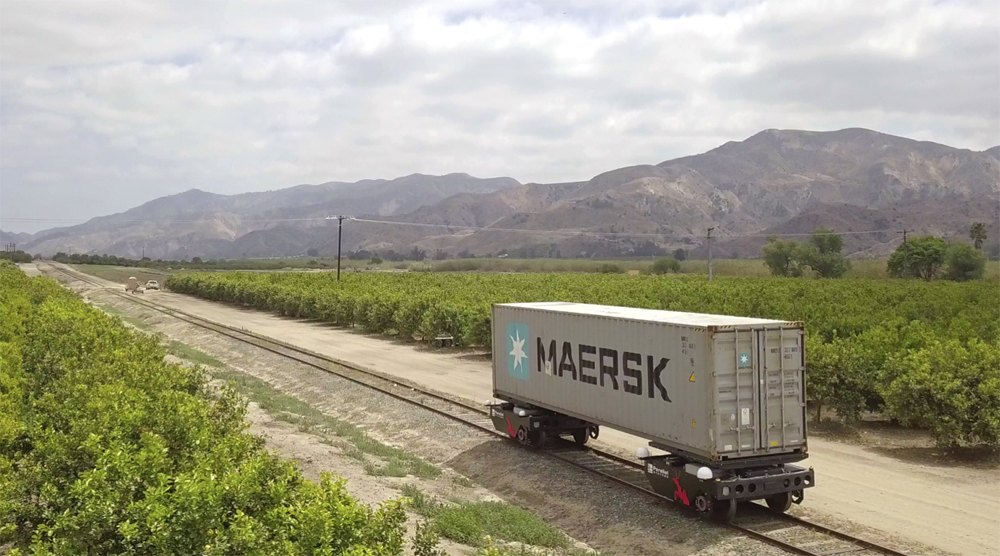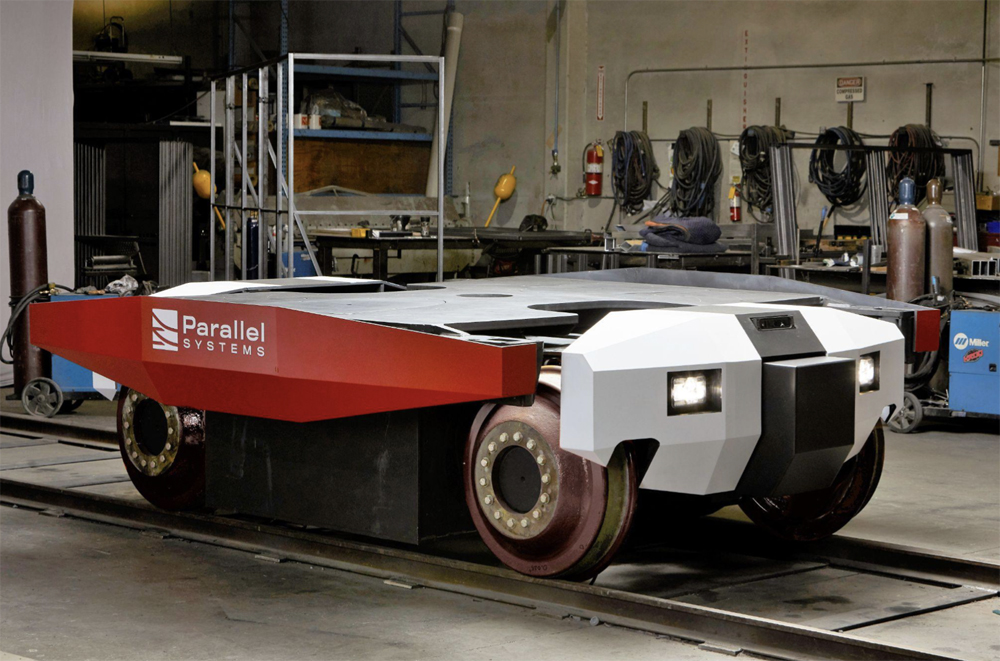
CULVER CITY, Calif. — Union Pacific has expressed interest in a new autonomous battery-electric intermodal car concept developed by a group headed by three former Space X engineers.
The concept under development by Parallel Systems would see intermodal containers carried by pairs of powered battery-electric wheelsets, moving in “platoons” of cars, but capable of splitting off to individual destinations en route. The company went public with its plan this week, saying it has raised $49.55 million for construction of the vehicles, as reported by CNBC, Fast Company, and other media outlets.
“We are interested in the Parallel System’s technology. We are familiar with it, and it is of interest. It’s of keen interest,” Union Pacific CEO Lance Fritz told investors and analysts on the railroad’s earnings call Thursday. “Candidly there are a lot of hurdles in front of that technology for deployment. Having said that, it could potentially be a game-changer if it proves out to be effective and workable. So I’d say keep your eye on it. We’re keeping our eye on it.”
The system would be unlikely to be ready before 2025. “But at some point it could be a technology that has utility for the U.S. rail network,” Fritz says.

Parallel Systems details the concept on its website, saying benefits would include the ability to smaller and less expensive terminals closer to shippers and customers, and reduction of greenhouse gases by moving current container moves by truck to the autonomous rail system. It says its model would make make container moves by rail financially feasible for shorter distance than the 500 miles currently considered the shortest economical move for railroads.
The team behind Parallel includes former Space X engineers Matt Soule, John Howard, and Ben Stabler, with a team of about 25 engineers with backgrounds including Tesla, Uber, and Google. The company is headquartered in Culver City. Among the company’s advisors is Dean Wise, former vice president of network strategy at BNSF Railway, who told Fast Company that the key to the concept is getting railroads interested: “You actually are not going to get into this game unless the railroads themselves are going to invite you in. The rail industry in North America is basically privately held and privately funded . . . and they can say, ‘We don’t like this [idea].’”














Somethings are missing here. What are the Brotherhoods going to say about this crewless vehicle? Who is the target market here? Looks like low-volume branch lines, or short-haul industrial areas. And how do you get the container off the wheelsets? Will these units obey block signals? Failed crossing gates? Very interesting, but they are only starting out.
Posted by mvlandsw on Thursday, January 20, 2022 7:33 PM
I can see that this might work where there is a branch line that leaves directly from a yard without having to use any mainline track. Shipments could be dispatched whenever they arrive in the yard instead of waiting for the next scheduled local train.
Track slots would not be as much of a problem. Hand throw switches leading to the receivers’ tracks and obstructions in the vehicle’s path may be.
Don’t think of this as a new way to just do intermodal. This could be the “everything” solution.
Mr. Oltmann, would you care to elaborate what you have in mind on the “everything”? I think the contract railroad workers and the retirees from those ranks deserve to know about the “everything” you have in store for us.
This is a very cool idea that could be a game changer. Could be the end of carload traffic. No reason each unit couldn’t spot itself in the customer’s siding without the huge overhead of serving yards, local trains, air tests, etc. etc.
Lots and lots of hurdles to clear though.
Would it be able to get through LA without being targeted by thieves ?
Teach one to through an snow covered switch in dark territory to clear the main for its cohorts and I may see some potential, though still limited. Make a one a short distance road legal hyrail, and I could see a little more potential. I guess I don’t see how it exploits the high axle load capacity of railroad, yet it remains shackled to a fixed corridor. It has the limited capacity of a truck without any of the flexibility of a truck.
The discussion reminds me of a college roommate that was a business major. The guy was very smart, and knew business in and out, but like many he knew very little about railroads. One day he declared to me that railroads “are dead” and pointless waste of capital. We debated the issue and I came to find out that he believed that railroads were truly point to point. He was completely unaware that railroad switches existed and therefor was unaware that railroads had the ability to interchange freight cars. He thought every rail line existed to serve only one pair of customers, and a train simply shuttled cars back and forth. Realizing the potential of interchange his opinion of railroading’s future changed drastically.
I guess the point is that many of us take for granted that the general public, and the business world, share some basic level of understanding on how the rail industry works, when in truth there are many people (and businesses) out there that have no idea. It is from this pool of individuals that “the next great idea to save the dying railroads” are sometime spawned, only to wither when presented with railroad reality.
Each car having its own motors? Look only as far as modern jet aircraft. Remember when they all had four engines? Now you will be hard pressed to find anything but two engines. It turned out that four engines really equaled double the chances of an engine failure. Here, a 110 cars have 220 motors.
Those individual cars moving still have to deal with grade crossings and cycle the crossing gates, something that has been a challenge for lightweight, single vehicles (such as the problems Denver had with their airport line, where the conventional gate equipment didn’t always see the car in the crossing block). On a line that now run 12 trains a day, that could mean as many as 1,320 cycles of the crossing signals, at about 35 seconds per time, minimum. That is 770 minutes per day – 54% of a day. Contrast that dozen trains at around 2.5 minutes per train, which is 30 minutes per day (2% of the day). That simple fact would push operators of the autonomous train cars to fleet them together in blocks, just as the company suggests on their website, possibly with a mechanism between them to pull a car with a disabled or otherwise not working motor set along. And needing a human or two to deal with unexpected emergencies and other problems a computer can’t handle.
We have a word for that. It’s a train.
This might work from a “set point A to set point B” on dedicated tracks, but it doesn’t seem at all feasible on any mainline tracks or for longer distances than say a few miles. I could see this only working for moving containers from say a port to a large yard maybe 25 miles away where they than get loaded on long Intermodal trains. Other than that, building dedicated tracks would be costly, take decades just to have environmental studies done and fight city after city who would undoubtedly oppose the projects. To me, it looks like a “huge loser” and I’d never invest my money in this venture.
Moving closer to John Kneiling’s “Integral Train Systems”.
https://cs.trains.com/trn/f/111/t/228469.aspx
https://www.abebooks.com/book-search/title/integral-train-systems/
I spent some time on their website and one of the interesting “advantages” of this concept was that if a “platoon” of cars is stopped for some reason and is blocking a crossing, they would separate themselves and open the crossing up.
Of course prior to two person crews and 15,000 ft. trains it was routine for crews to “cut the crossing” if they knew they were blocking a major highway for an extended time.
Does anyone know where that picture was taken at the top of the article? It looks like a former branch line possibly in Southern California.
Are you sure it’s a photo? Looks like a rendering to me. To me the tip-off is the ballast and ties.
It’s a photo, or possibly a still from a video. You can see the rest of the clip on their website. I think the inset picture of the prototype might be a rendering, it doesn’t really resemble what’s in the top photo.
Taken near Fillmore, California on the former Fillmore & Western, née former SP Santa Paula Branch
By definition, trains are never “autonomous”, they are automated. There is a difference….
Can’t wait to see this take over local distribution.